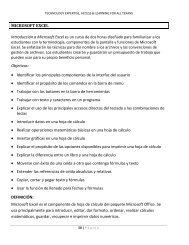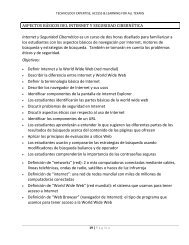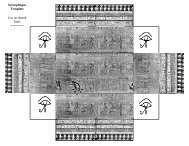Begin with the End in Mind: A Records Management & Archives ...
Begin with the End in Mind: A Records Management & Archives ...
Begin with the End in Mind: A Records Management & Archives ...
Create successful ePaper yourself
Turn your PDF publications into a flip-book with our unique Google optimized e-Paper software.
<strong>the</strong> archivist is shap<strong>in</strong>g <strong>the</strong> cultural and<br />
historical record and determ<strong>in</strong><strong>in</strong>g what story<br />
will be told today and <strong>in</strong> <strong>the</strong> future.<br />
Fortunately, <strong>the</strong> Texas State <strong>Archives</strong>, <strong>in</strong><br />
partnership <strong>with</strong> <strong>the</strong> Texas House of<br />
Representatives and Texas Senate, has<br />
already determ<strong>in</strong>ed that your legislative<br />
records are necessary and important to <strong>the</strong><br />
tell<strong>in</strong>g of Texas history. The <strong>Records</strong><br />
Retention Schedule of each legislative body<br />
lists those records hav<strong>in</strong>g endur<strong>in</strong>g archival<br />
value.<br />
Texas State Library, 1910, TSLAC<br />
6.2 Accession<br />
Accession<strong>in</strong>g <strong>in</strong>volves activities related to <strong>the</strong> legal and physical transfer of records to an<br />
archival repository. It <strong>in</strong>cludes pack<strong>in</strong>g records, review<strong>in</strong>g <strong>the</strong> general content of record<br />
boxes, complet<strong>in</strong>g legal paperwork and transport<strong>in</strong>g <strong>the</strong> records to <strong>the</strong> archives. As codified <strong>in</strong><br />
<strong>the</strong> <strong>Records</strong> Retention Schedule, when a particular records series meets its retention period,<br />
even when not yet physically transferred, legal custody of <strong>the</strong> legislative records is transferred<br />
to <strong>the</strong> Texas State <strong>Archives</strong>. Completion of <strong>the</strong> "Statement of Intent under Texas Government<br />
Code Chapter 306 & Chapter 323" form and actual physical transfer of <strong>the</strong> records completes<br />
<strong>the</strong> accession process.<br />
6.3 Arrangement<br />
Arrang<strong>in</strong>g and describ<strong>in</strong>g records is at <strong>the</strong> heart of what archivists do on a daily basis.<br />
Arrangement encompasses both <strong>in</strong>tellectual and physical activities, and description allows<br />
records to be identified and accessed.<br />
Arrangement is def<strong>in</strong>ed as "<strong>the</strong> process of organiz<strong>in</strong>g materials <strong>with</strong> respect to <strong>the</strong>ir<br />
provenance and orig<strong>in</strong>al order, to protect <strong>the</strong>ir context and to achieve physical or<br />
<strong>in</strong>tellectual control over <strong>the</strong> materials." Provenance is <strong>the</strong> pr<strong>in</strong>ciple of ma<strong>in</strong>ta<strong>in</strong><strong>in</strong>g <strong>the</strong><br />
<strong>in</strong>tegrity of orig<strong>in</strong> and use so that records of different orig<strong>in</strong>s (provenance) are kept separate<br />
to preserve <strong>the</strong>ir context. Orig<strong>in</strong>al order is <strong>the</strong> "organization and sequence of records<br />
established by <strong>the</strong> creator of <strong>the</strong> records."<br />
36






![Harry Potter [pdf]](https://img.yumpu.com/27329912/1/190x245/harry-potter-pdf.jpg?quality=85)
![Aplicaciones del Programa de Libros que Hablan [pdf] - Texas State ...](https://img.yumpu.com/27329907/1/190x245/aplicaciones-del-programa-de-libros-que-hablan-pdf-texas-state-.jpg?quality=85)








